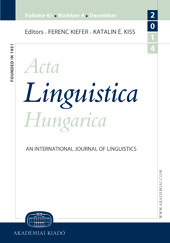The left periphery of CP phases in Japanese
The left periphery of CP phases in Japanese
Author(s): Keisuke YoshimotoSubject(s): Syntax
Published by: Akadémiai Kiadó
Keywords: CP phases; embedded topicalization/focalization; left periphery; feature inheritance;
Summary/Abstract: This paper discusses syntactic conditions under which complement clauses constitute a phase in Japanese. Since CPs are assumed to be phasal (Chomsky 2000; 2001), it is predicted by the Phase Impenetrability Condition that phrasal extraction out of a CP complement must transit through the edge of the complement, i.e., Spec CP. As Spec CP is an Ā-position and movement through an Ā-position must create a uniform Ā-chain, phrasal extraction out of a phasal complement is expected to create an Ā-chain. However, evidence from Japanese suggests that long distance A-scrambling is permissible out of some complement clauses that are headed by an overt complementizer (Uchibori 2000). It follows therefore that the category CP is not sufficient to characterize clausal phases. In search for an alternative definition of clausal phases, I argue that main clause phenomena such as thematic topics and exhaustive foci are allowed only in phasal complements in Japanese. Assuming that Top and Foc are licensed by Force (Haegeman 2006a), I propose that phasal complements project up to Force in their clausal left periphery, independently of a complementizer. I further argue that the correlation between phasehood and the clausal left periphery can be captured if we assume that uninterpretable topic and focus features must originate on the phase head Force.
Journal: Acta Linguistica Hungarica (Since 2017 Acta Linguistica Academica)
- Issue Year: 59/2012
- Issue No: 3
- Page Range: 339-384
- Page Count: 46
- Language: English

